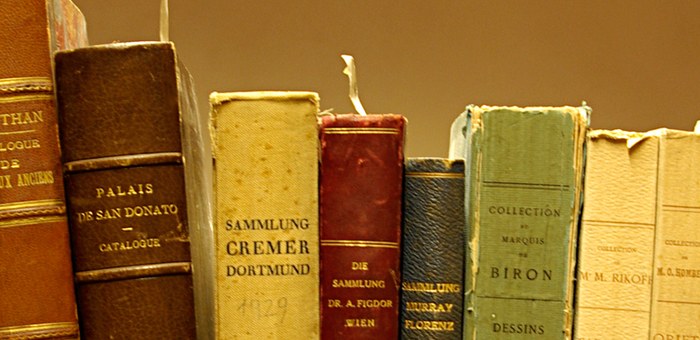The Zeri Library's collection of 37,000 auction catalogues is the largest in Italy. It includes Italian and foreign catalogues divided by nationality and date of sale, spanning from the late nineteenth century until 1998.
The most important nuclei are: British catalogues (15,500), French (4,000), German (3,000, including a large number of 19th-century exemplars), and Italian (2,000).
Besides these are catalogues from numerous European and American collections as well as nuclei organized by type: decorative arts (4,000), contemporary art (2,500), extra-European art (1,500), British painting (1,000).
The collection sprang from Zeri's contacts with collectors, antiquarians and auction houses. In some cases he took over private collections such as those belonging to the antiquarians Eugenio Di Castro and Alfredo Barsanti or, with the older catalogues, by careful browsing of the book market.
The collection is chiefly remarkable for the rarity of the auction houses and the fullness of the documentation from the scholar's market heyday, between 1960 and 1998. There are some extremely rare catalogues from the late 19th early 20th century which document the wholesale dispersion that marked the early decades of the century and throw light on some now dismembered collections of the past.
Along with catalogues there are sale-lists, calendars, auction previews and documents such as letters, notes and newspaper cuttings. The volumes are often annotated by Federico Zeri and other art historians, antiquarians and collectors giving prices, purchase details and information on the artworks sold.
The volumes catalogued provide evidence of over 1,000 auction houses, galleries and antiquarians, many of them only now figuring thanks to Zeri Foundation material, as is the case with the Ciardiello, Battistelli, Scopinich and Warowland catalogues.
They also document sales of little-known or quite unknown collections like the Friedlander (Simonetti, 1934), Guidi (Sangiorgi, 1902; Galardelli & Mazzoni, 1910), Spinelli (Galleria Bellini, 1934), and Conte Andrea di Robilant (Galleria Bellini, 1933) collections.
The Bologna Library holds over 18,000 volumes (new acquisitions included) available for consultation. All of them have been catalogued on the unified Bologna 'Hub' which belongs to the National Library Service (Opac SBN). The national book heritage is thus swelled by a collection that is unique in its field (70% of the books are not to be found in any other Italian libraries).
The other 21,000 catalogues are still kept at Villa Zeri in Mentana.
The 'Auction catalogues database'
Besides cataloguing, the Foundation has created a specific database for online consultation. It is perfectly integrated with the Zeri Photo Archive into which the data concerning the filed exemplars has been fed. The aim of the project was to link up information gleaned from auction sales to tables accompanying works and photographs in the photo archive databank. For the quantity of information it provides the Auction Catalogs database becomes unique, a tool serving to document and provide indispensable information on paintings, sculptures and objets d'art by which alone one may reconstruct dispersed collections and the history of collecting, above all in the nineteenth century.
It is above all fundamental in the case of catalogues lacking an iconographic apparatus or only partly illustrated. Knowledge of these is greatly augmented by photos of the works sold.
In sharing with and linking to photo-archive data and materials, the database facilitates immediate specific research of a kind impossible hitherto. As well as normal bibliographical search by Title, Author and Year of Catalogue, one can search by Place and Date of sale (DD/MM/YY), Auction Code, Collection, Type and Date of works sold.
This databank stands as a common platform for inter-institutional sharing of information on auction sales and works that at some point entered the market.
In cataloguing the first 14,000 volumes we benefited by a contribution from the Emilia-Romagna Region Institute for the Art, Culture and Nature Heritage. We were assisted by the Superintendency for the book and document heritage and the Management and Development Sector for the Bologna University Bologna Hub' catalogue.
